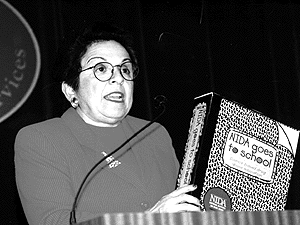NIDA has launched a new science education campaign to provide middle school students with information about how drugs work in the brain. "NIDA Goes to School," a compilation of resource materials, is being mailed to science teachers at 18,084 public and private middle schools across the country and 256 Department of Defense schools overseas. The campaign, undertaken in partnership with the National Association of Biology Teachers, was announced in November at the National Leadership Forum of the Community Anti-Drug Coalitions of America in Washington, D.C. In December, at a national press conference about teen drug use, Health and Human Services Secretary Dr. Donna E. Shalala cited the campaign as an effective tool for teaching young people how drugs damage their minds and bodies and helping them to resist drugs.
"Science-based education about drug abuse should be a prominent part of the curriculum for all students," says NIDA Director Dr. Alan I. Leshner. "This new initiative provides teachers easily usable, student-oriented materials to help achieve this goal."
 HHS Secretary Dr. Donna E. Shalala praised the "NIDA Goes to School" campaign at a recent national press conference on teen drug use.
HHS Secretary Dr. Donna E. Shalala praised the "NIDA Goes to School" campaign at a recent national press conference on teen drug use. The "NIDA Goes to School" kit contains a variety of research-based materials for teachers and students about drugs and how they affect the brain. (See "A Toolbox for Teachers") In addition, a "NIDA Goes to School" Web site has been established at NIDA's home page on the World Wide Web. Students and teachers can use this interactive Web site to get additional information about drugs of abuse. The site also will serve as a major source of feedback from students, teachers, and parents. As new science education materials are developed, they will be added to the site.
"We are very excited about this project," says Dr. Cathrine Sasek, science education coordinator in NIDA's Office of Science Policy and Communications. "Science teachers want information and resources that they can use in their classes. 'NIDA Goes to School' provides teachers with tools they can use to explain the neurobiology of substance abuse. We also hope that teachers will use NIDA as a source for additional fact-based information about drugs."
Many of the materials are written specifically for students in grades 5 through 9. Seven Mind Over Matter magazines feature the adventures of Sara Bellum, a girl who explores the brain's response to particular drugs and introduces key concepts in neuroscience. The series includes magazines on marijuana, opiates, stimulants, hallucinogens, inhalants, steroids, and nicotine. Each magazine unfolds into a poster with a quote from a noted scientist superimposed on a vivid color image of a brain area or neuron. For example, on the reverse side of the magazine on inhalants is a quote from Nobel Prize winner Albert von SzentGyÖrgyi (1893-1986): "Discovery consists of seeing what every has seen and thinking what no thought."
Also included in the materials is an interactive CD-ROM that features information on drugs of abuse in a variety of television show formats. Called ATOD-TV - ATOD stands for alcohol, tobacco, and other drugs - the CD-ROM was developed by Dr. Danny Wedding of the Missouri Institute of Mental Health with a NIDA Science Education Drug Abuse Partnership Award. In each ATOD-TV show, human and animated characters play out scenarios that illustrate different aspects of drug abuse and addiction. For example, "Neuronet" is a news program that provides information about the brain and how it is affected by drugs. "The Torn and the Troubled" is a soap opera that challenges myths about drugs and addiction. "Wheels of Misfortune" uses a game-show format to supply statistical information about drug use by different populations. An accompanying teacher's guide suggests student activities and provides a comprehensive list of resources for further information.
"Our goal for this campaign is to enhance science education, increase science literacy, and encourage young people to pursue careers in the sciences," says Dr. Sasek. "By introducing students to the science of drug abuse, we hope to stimulate their interest in neuroscience and substance abuse research."
To Receive This Resource
All materials in the "NIDA Goes to School" kit, with the exception of the ATOD-TV CD-ROM and teacher's guide, are available free from the National Clearinghouse for Alcohol and Drug Information. The materials also can be downloaded from NIDA's home page on the World Wide Web. The "NIDA Goes to School" Web site can be accessed from NIDA's home page.
A Toolbox For Teachers
The "NIDA Goes to School" kit contains the following publications and materials:
- Seven Mind Over Matter magazines and 40-page teacher's guide;
- "ATOD-TV" CD-ROM and 96-page teacher's guide;
- Marijuana: Facts for Teens, a 16-page brochure;
- Marijuana: Facts Parents Need to Know, a 28-page brochure;
- Preventing Drug Abuse in Children and Adolescents: A Research-Based Guide, a 38-page brochure; and
- Twenty NIDA Infofax information sheets on topics of interest to teachers, such as youth drug abuse trends, descriptions of more than 14 commonly abused drugs, and prevention and treatment methods.
